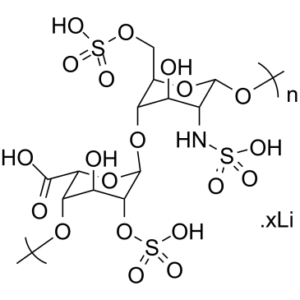This product is for research use only, not for human use. We do not sell to patients.

| Size | Price | Stock |
|---|---|---|
| 5g | $450 | Check With Us |
| 10g | $650 | Check With Us |
| 20g | $975 | Check With Us |
Cat #: V28838 CAS #: 9045-22-1 Purity ≥ 99%
Description: Heparin Lithium salt, a sulfated polysaccharide, is a highly potent anticoagulant which binds reversibly to antithrombin III (ATIII) (50-400 U/Kg).
References: Capila I, et al. Heparin-protein interactions. Angew Chem Int Ed Engl. 2002 Feb 1;41(3):391-412.
Publications Citing InvivoChem Products
Product Promise

- Physicochemical and Storage Information
- Protocol
- Related Biological Data
- Stock Solution Preparation
- Quality Control Documentation
| Molecular Formula | (C14H25NO20S3)n.xLi |
|---|---|
| CAS No. | 9045-22-1 |
| SMILES Code | O[C@H]1[C@H](O[C@H]2[C@H](OS(O)(=O)=O)[C@@H](O)[C@H](OC)[C@H](C(O)=O)O2)[C@@H](COS(O)(=O)=O)O[C@H](OC)[C@@H]1NS(O)(=O)=O.[n].[.xLi] |
| Synonyms | Heparin Lithium salt |
This equation is commonly abbreviated as: C1 V1 = C2 V2
- (1) Please be sure that the solution is clear before the addition of next solvent. Dissolution methods like vortex, ultrasound or warming and heat may be used to aid dissolving.
- (2) Be sure to add the solvent(s) in order.




































